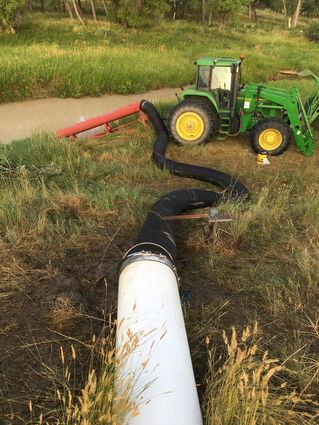Montana's Conservation Districts and the Stream Permitting Process
May 29, 2020

The stream permitting process applies to local ventures such as river crossings, private bridges, bank stabilization, or irrigation pump sites, such as the one pictured above, courtesy of Liz Riter.
By Liz Riter, NRCS Broadus
Healthy rivers and streams are important to Montanans for their lives and livelihoods: providing fisheries, clean water, recreation and aesthetics, agriculture and livestock production, as well as municipal water supply. Streams and rivers are also a complicated resource issue and one of the ways to protect their health is through the 310 permitting process.
By definition, a 310 Permit is needed by any private, non-governmental, individual, or entity activity that physically alters or modifies the bed or banks of a perennially flowing stream or river. This means any waterbody which has continuous year round flow is covered by the 310 Law, and the area the law covers goes from the bottom of the stream channel up to the banks (and the vegetation that grows along it) on both sides of the waterbody to the high water mark.
An applicant can find the application and instructions at the Montana DNRC website or by visiting your local Conservation District (or CD) office. The Powder River Conservation District is located in the USDA Building at 114 North Lincoln Street in Broadus (phone number 436-2321 x111).
Upon submission of a complete application, the CD may schedule a site visit, to evaluate the proposed approach of the project. The CD, paired with the applicant and a representative from Montana Fish Wildlife and Parks, forms a 310 inspection team for each permit application submitted. It is reasonable to anticipate between 30 and 60 days for the CD to process your application and schedule a site visit.
Upon granting and receipt of a 310 permit, the proposed work can proceed as described. It is important to note that the applicant is fully responsible for securing any other permits that may also be required, including permits related to floodplains, wetlands, or other related topics. All of these other permits are also described in the Joint Application Instructions.
There are also provisions for those that violate the laws related to activity that physically alters or modifies the bed and banks of a perennially flowing stream. The 310 Law provides that a project engaged in by any person without prior approval or activities performed outside the scope of written consent of the supervisors is subject to immediate abatement.
While the permitting process may seem complex, it serves to ensure that the original intent remains the focus of the procedures: evaluation and examination of activity which may potentially threaten the health and future of our important waterways. The route to securing a permit is straightforward and reasonable, while keeping in mind the crucial importance of our state's streams and rivers.



Reader Comments(0)